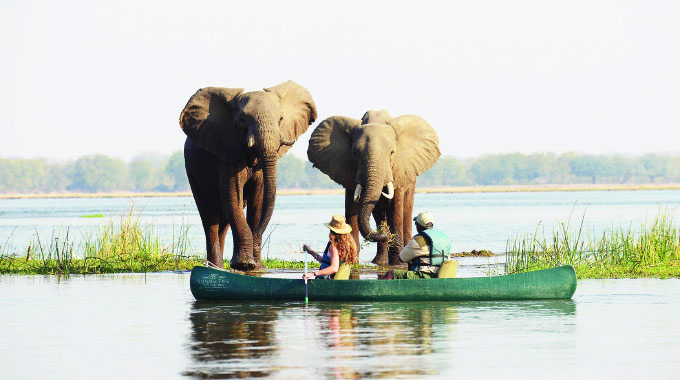Landscape conservation strategy: A pathway to Vision 2030

The development of a Middle Zambezi Landscape Conservation Strategy presents an innovative and proactive approach to conserve and utilise natural resources for social and economic growth in the northern most point of Zimbabwe straddling the Zambian border. In this report, Agric, Environment & Innovations Editor, Sifelani Tsiko (ST), speaks to African Wildlife Foundation Zimbabwe country director Olivia Mufute (OM) on why valuing natural capital can enable the Government to account for nature’s role in the economy and in the attainment of the Vision 2030 goals.
ST: Why the Middle Zambezi Landscape Conservation Strategy?
OM: We are bringing technical experts and other stakeholders to craft the strategy to make a statement around a bold vision for the future of our country.
We’re connecting the land, waters of the Zambezi to support healthy ecosystems, thriving fish and wildlife populations and vibrant communities.
Zimbabwe has a shared responsibility towards conserving its natural heritage and passing it on to future generations.
ST: What is the main reason for developing the Middle Zambezi Landscape Conservation Strategy?
OM: The main reason for this is to ensure that the Mid-Zambezi Landscape is conserved while at the same time contributing to Zimbabwe’s economic development. This landscape is very valuable because of its rich biodiversity.
It is of huge ecological significance not only to Zimbabwe, but to the region as a whole. It is among Zimbabwe’s four key elephant ranges.
ST: What are the major elements of this strategy?
OM: We are aligning this strategy with the AWF’s internal framework – the Landscape Conservation Process (LCP), a participatory, evidence-based framework used to plan, implement and measure conservation impact.
We also want it to be in line with the National Development Strategy (NDS1) for the next 10 years for the Mid-Zambezi Landscape.
ST: Does this strategy support the country’s NDS1 and Vision 2030 goals?
OM: Yes, it does. The Middle Zambezi Landscape Conservation Strategy is actually informed by the NDS1. The AWF actively participated in the technical working group on environment during the development of NDS1.
So, it is there to support NDS1 and it is also linked to the new AWF Zimbabwe Country Conservation Strategy 2020-2030. It largely aims to help the country attain its vision of becoming a middle income economy by 2030.
By developing this strategy, we want to make sure that we actualise the implementation of the national vision and issues articulated in NDS1.
ST: What is the importance of national accounting of the environment to this strategy?
OM: Already, Zimbabwe has initiated – through the ministries of finance and environment – a study to quantify the contribution of our biodiversity to the national economy. This landscape strategy will contribute to a better understanding of the status and value of the biodiversity in the Mid-Zambezi.
There is a process which is underway to develop a framework for national capital accounting. It would be very important to monitor the contribution and growth of this sector going forwards.
ST: When do you think the crafting of the strategy would be completed?
OM: It is not a long process and we hope to hold consultative processes with thematic groups and experts within a very short time. It should take us maybe three months.
ST: How will this strategy be beneficial to the local community?
OM: This strategy will be beneficial to the local communities because right now, they are part and parcel of the consultative process. They are setting the targets for the issues that they want prioritised on the ground themselves.
In the case of Mbire District Council where there is a land use plan, local communities are ensuring that the strategy is in line with the issues already identified – connectivity, conservation targets, viable wildlife populations, business opportunities, habitat connectivity and so on.
ST: What kind of support is the AWF going to be giving in the implementation of this strategy?
OM: The AWF has invested extensively in developing this strategy by using its own internal resources. The level of representation is quite massive at this meeting – we have three vice presidents of the AWF including technical experts from Washington DC, South Africa, Cameroon and Kenya.
This demonstrates our full commitment to the Mid-Zambezi Landscape Conservation Strategy. It also shows our long-term commitment to work in this landscape.
AWF has also invited various local stakeholders, including donors, development partners, local companies and the Government.
AWF also sees a lot of opportunities for partnership with the private sector to ensure long term funding including donor and bilateral funding.
It has identified Zimbabwe as a focal country among five priority countries in Africa. We are going to invest extensively in Zimbabwe over the next 10 years or more.
ST: Looking ahead, what are your hopes for the Mid-Zambezi Landscape Conservation Strategy?
OM: We are hoping to implement recommendations from this strategy. We are also looking forward to raising adequate funds and other resources and to develop partnerships with local and international investors to improve local community livelihoods.
We want to attract long-term investment that is green and climate smart.
We want this strategy to contribute meaningfully to the building of resilient local communities with various livelihood options. We envisage healthy and functioning ecosystems, thriving fish and wildlife populations and vibrant communities.








Comments